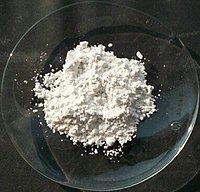Appearance white solid Molar mass 136.14 g/mol Density 2.32 g/cm³ Classification Sulfate | Formula CaSO4 Melting point 1,460 °C Soluble in Water | |
 | ||
Related compounds Thermodynamicdata Phase behavioursolid–liquid–gas | ||
Gypsum vs calcium sulfate anhydrite
Calcium sulfate (or calcium sulphate) is the inorganic compound with the formula CaSO4 and related hydrates. In the form of γ-anhydrite (the anhydrous form), it is used as a desiccant. One particular hydrate is better known as plaster of Paris, and another occurs naturally as the mineral gypsum. It has many uses in industry. All forms are white solids that are poorly soluble in water. Calcium sulfate causes permanent hardness in water.
Contents
- Gypsum vs calcium sulfate anhydrite
- Calcium sulfate
- Structures
- Uses
- Hydration and dehydration reactions
- Other uses
- Production and occurrence
- Discovery on Mars
- References
Calcium sulfate
Structures
The compound exists in three levels of hydration:
Uses
The main use of calcium sulfate is to produce Plaster of Paris and stucco. These applications exploit the fact that calcium sulfate forms a moldable paste upon hydration and hardens as a hemihydrate. It is also convenient that calcium sulfate is very poorly soluble in water, so structures do not dissolve.
Hydration and dehydration reactions
With judicious heating, gypsum converts to the partially dehydrated mineral called calcium sulfate hemihydrate, calcined gypsum, and plaster of Paris.This material has the formula CaSO4·(nH2O), where 0.5 ≤ n ≤ 0.8. Temperatures between 100 °C and 150 °C (302 °F) are required to drive off the water within its structure. The details of the temperature and time depend on ambient humidity. Temperatures as high as 170 °C are used in industrial calcination, but at these temperatures γ-anhydrite begins to form. The heat energy delivered to the gypsum at this time (the heat of hydration) tends to go into driving off water (as water vapor) rather than increasing the temperature of the mineral, which rises slowly until the water is gone, then increases more rapidly. The equation for the partial dehydration is:
The endothermic property of this reaction is relevant to the performance of drywall, conferring fire resistance to residential and other structures. In a fire, the structure behind a sheet of drywall will remain relatively cool as water is lost from the gypsum, thus preventing (or substantially retarding) damage to the framing (through combustion of wood members or loss of strength of steel at high temperatures) and consequent structural collapse. But at higher temperatures, calcium sulfate will release oxygen and act as an oxidizing agent. This property is used in aluminothermy. In contrast to most minerals, which when rehydrated simply form liquid or semi-liquid pastes, or remain powdery, calcined gypsum has an unusual property: when mixed with water at normal (ambient) temperatures, it quickly reverts chemically to the preferred dihydrate form, while physically "setting" to form a rigid and relatively strong gypsum crystal lattice:
This reaction is exothermic and is responsible for the ease with which gypsum can be cast into various shapes including sheets (for drywall), sticks (for blackboard chalk), and molds (to immobilize broken bones, or for metal casting). Mixed with polymers, it has been used as a bone repair cement. Small amounts of calcined gypsum are added to earth to create strong structures directly from cast earth, an alternative to adobe (which loses its strength when wet). The conditions of dehydration can be changed to adjust the porosity of the hemihydrate, resulting in the so-called alpha and beta hemihydrates (which are more or less chemically identical).
On heating to 180 °C, the nearly water-free form, called γ-anhydrite (CaSO4·nH2O where n = 0 to 0.05) is produced. γ-Anhydrite reacts slowly with water to return to the dihydrate state, a property exploited in some commercial desiccants. On heating above 250 °C, the completely anhydrous form called β-anhydrite or "natural" anhydrite is formed. Natural anhydrite does not react with water, even over geological timescales, unless very finely ground.
The variable composition of the hemihydrate and γ-anhydrite, and their easy inter-conversion, is due to their possessing nearly identical crystal structures, containing "channels" that can accommodate variable amounts of water, or other small molecules such as methanol.
Other uses
The hydrates are used as a coagulant in products such as tofu.
Up to the 1970s, commercial quantities of sulfuric acid were produced from the anhydride of calcium sulfate. Upon being mixed with shale or marl, and roasted, the sulfate liberates sulfur dioxide gas, a precursor in sulfuric acid production, the reaction also produces calcium silicate, a precursor in cement production.
When sold as a color-indicating variant under the name Drierite, it appears blue or pink due to impregnation with cobalt(II) chloride, which functions as a moisture indicator.
Production and occurrence
The main sources of calcium sulfate are naturally occurring gypsum and anhydrite, which occur at many locations worldwide as evaporites. These may be extracted by open-cast quarrying or by deep mining. World production of natural gypsum is around 127 million tonnes per annum.
In addition to natural sources, calcium sulfate is produced as a by-product in a number of processes:
These precipitation processes tend to concentrate radioactive elements in the calcium sulfate product. This issue is particular with the phosphate by-product, since phosphate rocks naturally contain actinides.
Calcium sulfate is also a common component of fouling deposits in industrial heat exchangers, because its solubility decreases with increasing temperature (see the figure).
Discovery on Mars
2011 findings by the Mars Opportunity rover show a form of calcium sulfate in a vein on the surface. Images suggest the mineral is gypsum.
